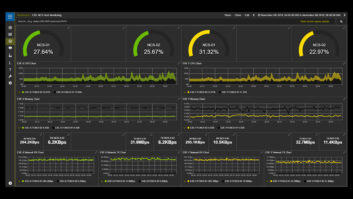
IP is low cost and widely available, but how suitable is it for live video links? Will it usurp SDI, or does coaxial still have a long life ahead of it? David Fox reports.
Internet protocol-based technology has been the future of broadcasting for years, but there have always been areas, particularly for live production, where specialist technology, such as SDI, has prevailed because nothing else could do the job so well. However, advances in IP-based systems could change that.
“SDI has been around a long time and is incredibly reliable, but it suffers with a lot of issues,” says Trevor Francis (pictured), Quantel’s director of Broadcast. “It’s very much a point-to-point system, doesn’t have a metadata payload and is half duplex (either one way or the other). It also relies on a lot of legacy hardware, such as routers.”
He believes that the move to SDI over IP is “logical and probably inevitable,” and it will mean that “instead of having to have physical infrastructure for SDI, we can build virtual systems that can link anywhere to anywhere, on demand.”
“There is a tendency in the industry to converge all networks into one technology, and the obvious one is IP/Ethernet,” says Lieven Vermaele, CEO of SDNsquare.
However the enterprise IP network, storage network, file-based media production network and SDI network each have different requirements and characteristics. To replace them with an all-encompassing IP/Ethernet network its key characteristics would have to be predictability and reliability. With these in place, “which is possible, IP is suitable for replacing SDI and for live video links, and this in a format independent way,” he adds.
“The real savings for productions result from harnessing the flexibility and productivity of IP workflows. When you are no longer dependent on expensive satellite uptime and entire production teams don’t need to travel great distances to carry out functions at venues that can be carried out remotely using existing infrastructure, the savings become significant,” says Mark Scott-South (pictured), director business development and co-founder of L2tek – licensees for the BBC Stagebox IP and responsible for developing the product and the market.
Although IP connections are often used for live video links, he admits there is still “a problem with accessing high-speed, well-managed QoS networks at the right price, and we don’t necessarily need to shoehorn IP into every point-to-point link where SDI is still the technology for the job.”
While IP wasn’t originally designed to deliver realtime packets, “if you implement the necessary tools such as forward error correction and variable bitrate encoding in the transmission, IP can easily handle live video,” says Paul Shen, CEO of TVU Networks. Its cellular ENG transmitters already deliver broadcast-quality HD video today with sub-second latency – even over unconditioned and less stable 3G and 4G networks.
“IP is not only low cost and widely available, but it has also reduced the cost of technology development due to the fact that it shields developers from designing for the physical layer. Depending on the application and environment, it is possible to transmit live video over IP in a predictable and reliable environment with low latency,” insists Shen.
“It is a myth that IP means higher latency or lower reliability,” agrees Jan Weigner, MD and co-founder of Cinegy. “The major part of live signals on TV today are transmitted via MPLS [Multi Protocol Label Switching] or other IP connections already.”
Nevion has supplied IP-based live video connectivity to many major live events over recent years, and Thomas Heinzer (pictured), Strategic Projects, Nevion, says its “IP codec technology allows the realtime transport of huge volumes of video, audio, communications and other data in a 100% secured way over generic IP infrastructure.”
“Our experience working with IP-based video and control solutions demonstrates the robust nature of IP on a daily basis,” says Jamie Shepperd, group marketing manager at Adder Technology. “Our technology delivers lossless dual-head or dual-link video across gigabit IP without latency, drop out or stutter.”
Adder recently commissioned a survey to find out how IP might be used in post. Some 38% of respondents currently use standard IP infrastructure to manage workflows, 29% use a combination of IP and proprietary technologies and just 13% use only bespoke. For those who have not made a full or partial move to an IP-based approach, the key concerns identified were the cost of upgrading facilities (38%) and bandwidth limitations (35%).
So predictable
“Standard IT networks are not really suitable for transport broadcast quality realtime video (and audio) as these networks lack mechanisms for synchronisation/timing and offer insufficient quality of service (guaranteed throughput/bandwidth and delivery),” argues Jan Eveleens, CEO, Axon Digital Design.
To make IP networks and data flows fully reliable and predictable requires: End-to-end QoS, guaranteed high bandwidth utilisation, intelligent load balancing over all possible paths, scalability to a high number of flows avoiding any mutual interference between these flows, and low (predictable) latency and jitter, adds Vermaele.
However, “most IP/Ethernet networks fall short of these requirements” offering only best-effort QoS. “However, this doesn’t mean that IP/Ethernet technology would not be capable of fulfilling these requirements.”
“The benefits of IP are well documented, including the fact that it is everywhere. But it does have limitations, which make its use for high-quality live-content a challenge,” agrees Heinzer.
“IP networks can be much more reliable than SDI networks especially when it comes to seamless failover. You just need the right stuff – the right switches, proper cabling and of course the right architecture to start with. The new SDN products help,” says Weigner.
“IP can be completely reliable and predictable in a controlled environment,” says Shen (pictured). “However, when IP is in a public environment such as the internet, there will always be some kind of unpredictability. In a video-over-IP environment, compression, packet loss, and packet jitter can magnify its impact on picture. As a result, a number of technologies such as error correction are often used minimise the impact of the interference.”
To combat interference, TVU uses variable bitrate encoding, so that the transmission continues when network throughput fluctuates, together with forward error correction allowing live HD to be transmitted reliably, even over very unreliable 3G/4G links or the public internet.
“The key to success when using IP networks is to plan ahead and test out your connections, especially when you plan to load the system with heavy data traffic and you’re routing through multiple switches,” says Scott-South. “For good quality video links, it’s not just a case of turning up and plugging into the nearest Ethernet port, at least not yet. We have worked with a number of carriers and across many third party networks with appropriate network management tools and the results have absolutely been predictable and reliable. Just don’t expect to use 99% of the theoretically available capacity on a shared network and think you’ll get away with it.”
As part of its first RevolutionQ project, Quantel is now working with video over IP, taking delivery of signals that arrive as RTP streams. Although the signal will typically be transmitted over IP compressed (at 10, 15 or 20Mbps), the first thing the central server will do is to convert it to 100Mbps AVC-Intra, which considerably increases the data storage needed. “If the customer is acquiring huge amounts of content, such as for news or sport, they don’t want to have this multiplication of storage. So, if we can store the files as transmitted over IP and then only convert the finished result to a more traditional broadcast file format, it is much more efficient. Particularly as news, for example, only uses 1% or less of the original media,” says Francis.
Standard deviation
“Audio/Video Bridging (AVB) is currently the best (only) way to reliably transport realtime, uncompressed audio and video across Ethernet networks with very low latency (2ms network latency),” claims Eveleens. “It provides synchronisation, bandwidth management/protection and traffic shaping (and some more) and has been standardised by the IEEE so is open for everybody to use.”
SMPTE’s 2022 range of standards can map video and other broadcast signals over IP, and 2022 “scales nicely for both compressed and uncompressed broadcast signals and makes use of generic IP infrastructure in the core networks,” responds Heinzer. “SMPTE 2022-based equipment has proven its reliability for live broadcast signals over wide area networks, thus enabling improved workflow and cost efficiency for live productions. SMPTE 2022-encapsulated video, audio and data can be used in the broadcast facility and for any type of live content exchange network, whether it’s a local campus environment or a global wide area network,” he says.
“In comparison, AVB is designed for the local area or facility only, does not support any options for compression and demands specialised Ethernet infrastructure,” argues Heinzer. “In order to transport AVB mapped content over IP networks, converters from AVB to IP are necessary, which represents a huge disadvantage on the way to an all-IP broadcast world.”
“AVB has promise, but due to the fact that it requires switches, network cards, etc., to understand, it will have a hard time finding adoption unless some giant like Intel or Apple pushes it,” states Weigner (pictured). “The various SMPTE 2022 standards work on standard Ethernet but are missing a trick on supported codecs or even stipulate uncompressed. In the age of HEVC that is unrealistic. DVB or simple transport streams with any choice of codecs inside sounds like the winner to me and this is what we put our money on while keeping our options open to where the market is going.”
AVB is very restrictive in defining how to build a compliant network and in how streams and resources are reserved. “This reduces the efficiency and scalability of the infrastructure. And it leaves the calculations and provisioning up to the end user, an almost impossible task in an environment with a lot of flexibility and many variable processes,” adds Vermaele.
“In terms of Clock synchronisation AVB is a restricted subset on the more general IEEE 1588, where it requires that every device in the network is compatible with the proposed protocol.” This restricts it to an AVB-compliant switch, which disqualifies 99% of current switches. He feels that AVB places too many restrictions on network design to make it a practical SDI replacement. For example, “if one would try to scale an AVB network to replace an HD-SDI matrix, the AVB network would be limited to the equivalent of a 2×2 matrix.”
IEEE 802.1 (for such things as Time Sensitive Networking) is another standard for a controlled IP environment, while other techniques (such as the proprietary protocols developed for TVU Grid) can optimise live video transmissions over uncontrolled public internet. There is also Stagebox, created by the BBC, to bring IP to the camera and, “where possible, staying in IP throughout the workflow, using standard network infrastructure, transport protocols and native codecs, to best make use of what is already available,” explains Scott-South. “AVB, which uses 10Gbps links to most closely replicate the characteristics of SDI, and SMPTE 2022, which strives to make up for network inadequacies, are still relevant. However, IT teams have perfectly good protocols already in place and with the massive increase in network backbone capacity, many of the issues the broadcast standards are trying to address are no longer relevant.”
As far as QoS is concerned, “there is no such thing as a standard IP/Ethernet switch. Which leads to the situation that mixing different type of network switches will always lead to non-guaranteed, lower or even uncontrolled/variable QoS,” says Vermaele. He maintains that the best response is to use Software Defined Network applications to deliver the end-to-end QoS needed for an SDI or live video network replacement, but this will currently only work with certain 10/40Gbps IP switches.
Beyond HD
Is the move to 4K the ideal junction to move to IP-based technology for shifting these large amounts of data around?
“SDI will be able to handle UHD. However, SDI remains a one way, single-purpose, and point-to-point connection. 4K will provide a natural point for broadcasters to transition to a more flexible interface,” agrees Shen.
Research is underway to create a version of SDI that can carry UHD, “but it will be pushing the boundaries, cable length will definitely be a challenge and it will remain a very limited, circuit-switched, uni-directional, very industry-specific interface with a minimal cost erosion curve,” adds Eveleens.
However, Ethernet is moving towards 1Tbps in the next decade. “That is much more than SDI will ever be able to offer,” he adds. “With Ethernet technology becoming cheaper (10GbE port already cheaper than a 3Gbps port today) and faster every day and with the AVB standards in place, it is almost a no-brainer to make the step from SDI to IT networks now. ”
Adder’s KVM products use standard 1Gb IP networks to carry lossless 2560×1600 resolutions at 60fps alongside audio, USB and RS232. “With 10Gb networks becoming commonplace, and 100Gb networks already beginning to appear, the mantra ‘never bet against bandwidth’ will see IP networks happily carry 4K feeds and much more,” predicts Shepperd.
Cinegy demoed 4K over IP at IBC2013. “Our products can do that out of the box, today. UHD/4K is the defining point in time where SDI failed to deliver and IP did – and does,” says Weigner.
“We have to avoid that organisations have to do another investment for one specific video format. We need a solution that can cope with future developments in video formats and with variable resource requirements,” says Vermaele. By introducing IP now, with a controlled QoS, he believes the SDN concept and the availability of 10/40 (and coming 100) Gbps IP/Ethernet switches, will allow format-independent video networks, for live and non-live, for 2K, 4K, 8K and up, for different frame rates and colour depths.
“I do not believe that SDI is dead, but beyond HD perhaps it is time to consider fibre rather than cable,” states Scott-South. “4K 60fps, which is surely the minimum acceptable specification for UHDTV, already requires 12Gbps bandwidth down a single link, and all indications are that we will move quickly to higher frame rates and resolutions. Semtech, the world’s leading manufacturer of SDI interface components, is already looking to 8K 120fps deep colour, requiring 48Gbps speed and is working with SMPTE to standardise that in SDIw.”
www.adder.com
www.axon.tv
www.cinegy.com
www.l2tek.co.uk
www.nevion.com
www.quantel.com
www.sdnsquare.com
www.tvupack.com







